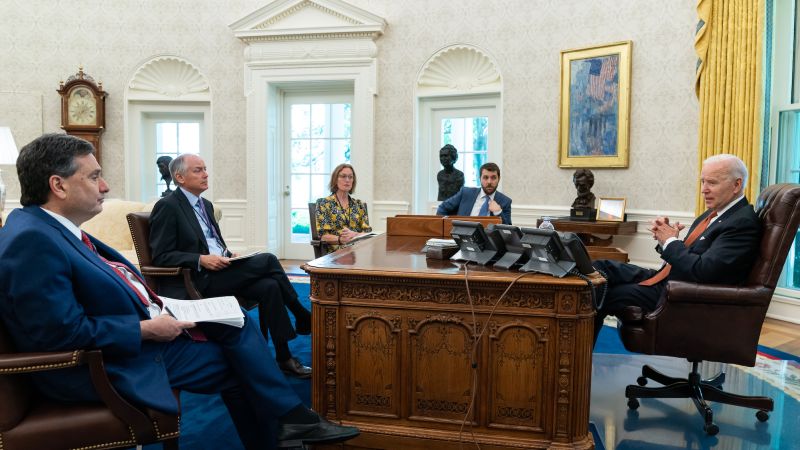“This was never about the money, this was about us against the system,” says tousled-haired bank robber Bodhi in the 1991 film Point Break. Played by Patrick Swayze, this chiselled hippie-like adrenaline junkie is explaining his modus operandi to his followers around a campfire: they’re socking it to The Man by standing up to a system that “kills the human spirit”. The fact that the gun-toting, surfing-mad gang carry out their robberies wearing rubber masks of former US presidents, including Ronald Reagan and Richard Nixon – earning them the moniker “the Ex-Presidents” – adds macabre humour to their outlaw spirit, even as they’re pursued by Keanu Reeves’s dogged FBI agent.
The scenario is, of course, total bunkum. It was a slice of gung-ho Hollywood fiction that performed well at the box office but was about as credible in real life as a takeover by the malevolent AI robots of that summer’s other blockbuster, Terminator 2: Judgment Day. But no one told Seattle resident Scott Scurlock.
In June 1992, Scurlock mimicked Point Break by robbing a branch of Seafirst Bank in his home city. Wearing prosthetic make-up and backed up by an accomplice in a Reagan mask, the free-spirited, handsome and tousled Scurlock held up the branch at gunpoint and escaped with just under $20,000. It was the first of 19 robberies over a four-year period that would net over $2.3 million for Scurlock, who was immediately nicknamed “Hollywood” because of the Bodhi similarities. Along with his gang, known as “the Hollywood Bandits”, Scurlock topped the FBI’s most-wanted list and attracted a bounty of $50,000.
“Hollywood” became the most prolific bank robber ever in America’s Pacific Northwest. Almost as notable as the lengths he went to to cover his tracks was the fact that Scurlock was something of a legend among Seattle beatniks in the early 1990s. He lived in a 75-feet treehouse he built himself (friends called him “Tarzan”), he looked like Mel Gibson and was an inveterate ladies’ man. An apparent reverence of Robin Hood, who stole from the rich to give to the poor, was the only possible clue to Scurlock’s secret life (as it turns out, he was better at the first half of Hood’s epithet than the second).
“He perfected his craft,” says Shawn Johnson, the FBI Special Agent tasked with catching Scurlock, in a new Netflix documentary film called How to Rob a Bank. “Money was part of it. But it was the adrenaline rush… the challenge,” Johnson explains.
Seattle in the early Nineties was a city in transition and a place of contradictions. Historically famous for just two big corporations, Boeing and timber company Weyerhaeuser, money suddenly poured in with the growth of Microsoft, Amazon and Starbucks. Banks opened everywhere. On the flip side, local grunge heroes Nirvana emboldened fans with their anti-establishment viewpoint and Kurt Cobain’s sung belief that they’ve “gotta find a way, a better way”. Rivers of cash and a revolutionary call to arms. The ingredients were in place.
Scurlock, 37 at the time of his first robbery, had a normal childhood. Born William Scott Scurlock in Virginia to a minister father and a teacher mother, he lived in Hawaii before settling in the Northwest. Fearless if secretive, Scurlock enrolled at the alternative-leaning Evergreen State College in 1978 with a view to studying medicine. Instead, he discovered the chemistry lab and started making methamphetamine, or crystal meth. His product was known for its purity. The son of a preacher man soon turned producing meth into a lucrative livelihood. He’d supply a man known as Captain Pat, who’d sell the drugs. Things came to an abrupt halt when Pat was murdered in a bungled robbery. Freaked out, Scurlock stopped making drugs. He’d need an alternative income.
Friends had no inkling what was to come. Rather, they marvelled at Scurlock’s enterprise. With friends’ help, he built a towering six-storey treehouse in Thurston County, south of Seattle. It had 30 windows and a working loo, shower and oven range. “Tarzan” would host wild parties there, sometimes opening the door naked except for a tool belt. It was with his treehouse co-dweller Mark Biggins that he hatched his outlandish plan.
The first robbery was decidedly amateur. After Scurlock called Biggins by his first name in front of terrified customers, his friend fled to Montana. But with new accomplice Steve Meyers, a poetry-loving sculptor, Scurlock honed his technique. The disguises were everything. Scurlock created a fake chin, cheekbones, nose and moustache using Hollywood-grade prosthetics. He’d wear a wig, sunglasses and, always, a baseball cap with the “D.A.R.E.” logo on it. The cap referenced a famous police-led, anti-drugs school campaign (standing for Drug Abuse Resistance Education), and Scurlock wore it as a decoy to suggest he was linked to the force.

Costumes aside, the pair would use radio scanners to check police movements, they’d always burn their clothes, they’d hide their other gear in locked and buried military canisters, and they’d launder the money via betting shops. Scurlock bought getaway cars via third parties so his name wasn’t recorded. He’d even plant female hair in the cars so that any DNA evidence wouldn’t point to them. In robbing terms, this was a belt and braces approach.
The thefts became more audacious. Scurlock moved from robbing cash from the tellers (low thousands) to breaking into vaults, where the big money was kept. The fifth robbery, in November 1992, provided the breakthrough: the Bandits stole $252,000. The police and the FBI were flummoxed. Scurlock used his cash to travel to Bhutan and Ecuador. He also donated to the Earth First environmental charity (Robin Hood hadn’t totally deserted him).
But things started to go wrong. A security “dye pack” exploded in one stash of notes, while a customer recognised his “Hollywood” character strolling into another bank. The FBI’s Johnson cleverly calculated that the thief was spending $21,000 each month and therefore predicted when the robberies might be. Further, banks started stashing new-fangled tracking devices called ProNets inside cash, making it easier for looters to be caught.
Scurlock himself was getting frustrated, resorting to violence in one robbery. He wrote in his diary that he felt “captured” by the lifestyle. He also wrote, “Where the f— do I go from here, O great winged white horseman in my mind?” He resolved to do one last big heist – netting himself millions – before quitting for good. It would indeed be his last.
On Thanksgiving Eve 1996, Scurlock, Meyers and Biggins (who’d returned) held up the Lake City branch of Seafirst Bank. They snatched $1,008,000 but not before bank manager Scott Levine dropped an extra ProNet into their bag. The men riffled through the cash as their getaway van screeched through the wet streets. They threw a few tracking devices out of the window but one eluded them. The FBI and the police gave chase. A shootout ensued and the game was up. While Meyers and Biggins were captured, Scurlock escaped and hid in a stationary motorhome overnight. It was surrounded by five officers who filled the vehicle with pepper spray. Cornered, Scurlock killed himself with a single shot from his own gun. Hollywood was dead.
The Netflix documentary, which clocks in at under 90 minutes, contains jaw-dropping archive footage in a story that gets increasingly bonkers. Still, press reports from the time, not featured, suggest that police missed numerous opportunities to quiz Scurlock. And he certainly wasn’t as circumspect with his cash as his apparent care suggested.
According to the Seattle Times in 1996, Scurlock’s drink of choice at Olympia’s trendy Budd Bay Café was champagne. Despite driving a beaten-up 1940s truck, he’d buy Dom Perignon or Cristal at $125 a bottle, according to owner Brett Hibberd. The same article reports that Scurlock had four run-ins with the police for unrelated incidents during his robbing years, including for being a passenger in a car caught doing doughnuts and for angrily telling a neighbour to stop putting real estate signs up on their remote road. Could he have been apprehended sooner?
Ultimately, though, Scurlock’s spree is a cautionary tale. The early novelty of re-enacting Point Break clearly wore off as time passed. “It’s not tragic to die doing what you love,” insists Bodhi in the film. What’s abundantly clear from Scurlock’s diary, however, is that the man with the prosthetic face didn’t actually love his Hollywood fantasy at all.
How to Rob a Bank is on Netflix now
Signup bonus from





